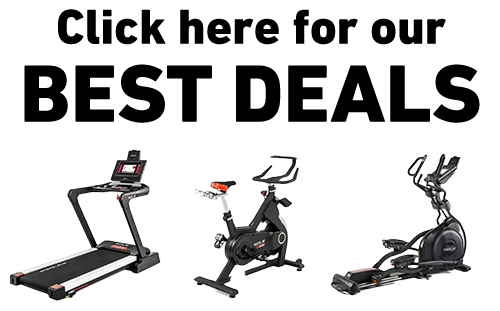Key Takeaways
- Foot numbness on an elliptical is often caused by poor circulation or incorrect foot positioning.
- Wearing tight shoes can exacerbate numbness and discomfort.
- Adjusting foot placement and distributing weight evenly can help alleviate numbness.
- Taking regular breaks and wiggling your toes can improve blood flow.
- SOLE ellipticals are designed to offer comfort and reduce foot numbness during workouts.
|
At SOLE Fitness, we’re proud to offer the best treadmills for your home or gym. These machines are crafted to meet the highest standards of quality and performance, ensuring they are ideal for anyone - from fitness novices to seasoned athletes. Featured Products SOLE Ellipticals: Priced from $1,199.99, SOLE ellipticals are known for their ergonomic design, durability, and affordability. They provide a quiet, smooth workout with intuitive consoles, adjustable stride lengths, incline options, and heart rate monitoring, ensuring a comprehensive exercise experience. |
Common Causes of Numb Feet on an Elliptical
Foot numbness, also known as paresthesia, is a common issue for many people using ellipticals. It can be quite frustrating to experience this sensation, especially when you're trying to focus on your workout. But don't worry, there are ways to address and prevent it.
Several factors contribute to foot numbness on an elliptical:
- Poor Circulation: When your feet are in a fixed position for an extended period, blood flow to your toes can be restricted, leading to numbness.
- Incorrect Foot Positioning: Placing too much pressure on the balls of your feet can compress nerves and blood vessels, causing that tingling sensation.
- Wearing Tight Shoes: Shoes that are too tight can restrict blood flow and add pressure to your feet.
"Constant pressure on a nerve or aspect of your foot for a prolonged period of time can cause you to experience numbness in your toes and feet." - Kimberly Steward, Banner Health
Effects of Poor Circulation
Poor circulation can have several effects on your feet - in addition to numbness, you may also experience cold feet, cramping, or even swelling. These symptoms can hinder your workout performance and overall comfort.

It's crucial to maintain good circulation to ensure your feet stay healthy and comfortable during exercise. This can be achieved through proper footwear, adjusting your foot positioning, and taking regular breaks.
Importance of Foot Health
Your feet support your entire body weight and are essential for balance and mobility, so neglecting foot health can lead to various issues, including chronic pain and reduced mobility.
Therefore, it's important to pay attention to any signs of discomfort or numbness and take steps to address them. This will improve your workout experience and contribute to your overall well-being.
Mistakes to Avoid
Wearing Tight Shoes
One of the most common mistakes is wearing shoes that are too tight - they can restrict blood flow and add unnecessary pressure on your feet, leading to numbness.
Make sure to wear properly fitting shoes with enough room in the toe box to allow for better circulation and reduce the risk of numbness.
Incorrect Foot Positioning
Another common mistake is incorrect foot positioning on the elliptical pedals: placing too much pressure on the balls of your feet can compress nerves and blood vessels, causing numbness.
Try to distribute your weight evenly across your entire foot. This can help reduce pressure points and improve overall comfort.

Ignoring Discomfort
Ignoring early signs of discomfort can lead to more severe issues. If you start to feel numbness or tingling, take a break and adjust your foot positioning.
Tips to Protect Your Feet
Selecting Proper Footwear
Your shoes should provide adequate support and cushioning to reduce pressure on your feet, so you need to look for shoes with a roomy toe box to allow your toes to move freely. This can help improve circulation and prevent numbness.
It's also important to ensure that your shoes fit well; shoes that are too tight can restrict blood flow, while shoes that are too loose can cause your feet to slide around, leading to blisters and discomfort. Consider getting your feet measured to find the perfect fit.
Adjusting Foot Placement
How you place your feet on the elliptical pedals can significantly impact your comfort; placing too much pressure on the balls of your feet can compress nerves and blood vessels, leading to numbness. Instead, try to distribute your weight evenly across your entire foot.
One way to achieve this is by adjusting the angle of your feet. Experiment with different foot placements until you find a position that feels comfortable. Keep your feet flat and avoid leaning too far forward or backward.
One of SOLE’s ellipticals - the E95 - has adjustable pedals made possible with a “worm drive” dial, which allows users to dial in exactly where they want the pedal to be angled. As a result, users may not feel as much pain and numbness.

Distributing Weight Evenly
Maintaining an even distribution of weight across your feet can help prevent numbness. When using an elliptical, it's easy to shift your weight forward onto the balls of your feet, especially if you're focusing on your workout. However, this can lead to discomfort and numbness over time.
Instead, try to keep your weight centered over your entire foot: this can help reduce pressure points and improve overall comfort. If you find it difficult to maintain an even weight distribution, consider adjusting the resistance or incline settings on your elliptical to find a more comfortable position.
Taking Regular Breaks
Taking regular breaks during your workout can help prevent numbness by allowing your feet to rest and recover. If you start to feel numbness or tingling, take a short break and wiggle your toes to improve circulation.
It's also a good idea to incorporate breaks into your workout routine, even if you're not experiencing discomfort. This can help prevent numbness from developing in the first place and improve your overall workout experience.
Importance of Stretching
Stretching before and after your workout can help improve circulation and prevent numbness. Focus on stretching your calves, ankles, and feet to improve flexibility and reduce tension.
Simple stretches like calf raises, ankle circles, and toe stretches can be highly effective. Incorporating these stretches into your routine can help keep your feet healthy and comfortable.

Benefits of Toe Movement
Moving your toes regularly during your workout can help maintain blood flow and prevent numbness, so try wiggling your toes or flexing your feet periodically to keep the blood circulating.
Incorporating toe movement into your workout routine can be a simple yet effective way to prevent foot numbness.
Adjusting Workout Intensity
Adjusting the intensity of your workout can also help prevent numbness, so if you're experiencing discomfort, consider lowering the resistance or incline settings on your elliptical. This can reduce the strain on your feet and improve overall comfort.
Gradually increasing the intensity of your workout over time can help your feet adapt and prevent numbness. Start with a lower intensity and gradually increase it as your feet become more accustomed to the exercise.
Final Thoughts
Foot numbness on an elliptical can be frustrating, but it doesn't have to be a permanent issue. By understanding the common causes and taking steps to address them, you can improve your comfort and prevent numbness.
Wear properly fitting shoes, adjust your foot placement, distribute your weight evenly, and take regular breaks. Incorporating stretching and toe movement into your routine can also help improve circulation and prevent numbness.
SOLE ellipticals are designed to offer comfort and reduce foot numbness during workouts. Investing in a high-quality elliptical like those from SOLE can help you have a more enjoyable and effective workout experience. If you already have a SOLE elliptical, make sure to use it in a way that protects your feet as discussed above.
Frequently Asked Questions (FAQ)
Why Do My Feet Go Numb?
Foot numbness on an elliptical is often caused by poor circulation or incorrect foot positioning. When your feet are in a fixed position for an extended period, blood flow to your toes can be restricted, leading to numbness. Placing too much pressure on the balls of your feet can also compress nerves and blood vessels, causing that tingling sensation.
What Shoes Should I Wear?
Choosing the right footwear is crucial when using an elliptical: your shoes should provide adequate support and cushioning to reduce pressure on your feet, so look for shoes with a roomy toe box to allow your toes to move freely. This can help improve circulation and prevent numbness.
How Can I Adjust My Foot Position?How you place your feet on the elliptical pedals can significantly impact your comfort. Placing too much pressure on the balls of your feet can compress nerves and blood vessels, leading to numbness. Instead, try to distribute your weight evenly across your entire foot.
Is It Normal to Feel Discomfort?While some discomfort can be normal during a workout, persistent numbness or pain is not. If you start to feel numbness or tingling, take a break and adjust your foot positioning. Listening to your body and making necessary adjustments can prevent numbness and improve your workout experience.
How Often Should I Take Breaks?It's a good idea to incorporate breaks into your workout routine, even if you're not experiencing discomfort. This can help prevent numbness from developing in the first place and improve your overall workout experience.




Leave a comment
This site is protected by hCaptcha and the hCaptcha Privacy Policy and Terms of Service apply.